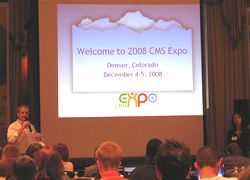The Joomlashack Blog
3rd Annual Joomlashack Charity Contest- Vote Now
- Written by Tom Elliott Tom Elliott
- Published: 19 December 2008 19 December 2008
NOTE: Voting on this contest closed on 1/4/2009. Want to support our 2009 charitable efforts? Read about our matching program!
 Support these five charities, but vote for just one!
Support these five charities, but vote for just one!
Last month we asked our Joomlashack community to nominate their favorite charity for a $1,000 USD cash prize. Within 10 days, we had nominees from all corners of the globe and doing incredibly diverse work. Our team carefully reviewed every entry and then narrowed our list down to the five nominees below as our favorite five.
Please check out and then support each of these excellent and deserving organizations with an online contribution, and then vote for the charity that you think is most deserving of our $1,000 USD cash prize.
Voting ends Sunday, January 4th at 11:59pm EST
Simplicity: A Powerful but Light Joomla 1.5 Template
- Written by Tom Elliott Tom Elliott
- Published: 14 December 2008 14 December 2008
 Simplicity has been on the shelf at Joomlashack ever since Joomla's release, and no doubt it has been one of your favorites.
Simplicity has been on the shelf at Joomlashack ever since Joomla's release, and no doubt it has been one of your favorites.
This month we've taken the time to go over this template with a fine-toothed comb in an effort to maximize its efficiency for Joomla! 1.5.
Simplicity is still one of the fastest templates in the world, almost 18 months after its release, and it remains one of the few source ordered, hard-core SEO templates around.
Today we'd like to invite you back to the Simplicity demo to have a look at its progression into the Joomla! 1.5 realm.
Check out these excellent new features:
Read more: Simplicity: A Powerful but Light Joomla 1.5 Template
CMS Expo Denver - Joomla Fun a Mile High
- Written by Tom Elliott Tom Elliott
- Published: 14 December 2008 14 December 2008
 Joomlashack was in the house for CMS Expo Denver last week, and enjoyed a three days of packed Joomla action.
Joomlashack was in the house for CMS Expo Denver last week, and enjoyed a three days of packed Joomla action.
The Expo brought together for the second time a dogpile of friends and colleagues in the Joomlaverse, including our buddies at Azrul.com (Makers of JomSocial), MyBlog, JomComment, and other excellent extensions for Joomla), and dozens of other Joomlaheads.
Joomlashack's 3rd Annual Charity Contest Opens!
- Written by Tom Elliott Tom Elliott
- Published: 20 November 2008 20 November 2008
Nominations extended to December 8th!
 Has there ever been a time when non-profits needed our support more?
Has there ever been a time when non-profits needed our support more?
The world's many problems- dirty water, hungry children, oppressed people, forgotten animals- are often only solved by the dedicated volunteers and staff of our non-profits and NGOs. In a time of darkness, these organizations make the world brighter.
Announcing our 3rd Annual Charity Contest- where our community nominates and chooses a deserving charity to win a 1,000 USD cash donation.
Discuss the charity contest in our forum!
CMS Expo Denver: Best Offer Yet!
- Written by Tom Elliott Tom Elliott
- Published: 12 November 2008 12 November 2008
Still thinking about CMS Expo Denver? Here's the best offer yet!
Joomlashack friends and customers get $50 off your registration- just $499!
Register 3 or more and get $100 off your registration fees- $449 per person!
Learn more about CMS Expo Denver and register today!
Announcing Optimus, the latest free Joomla 1.5 template from Joomlashack
- Written by TJ Baker TJ Baker
- Published: 28 October 2008 28 October 2008
Looking for a Professional Grade Free Joomla! 1.5 Template? 
Our latest free Joomla! template features 800/1024/Fluid layout options, custom column widths, and is loaded with beautiful typography and other convenient options.
If you like how Optimus performs, you can easily upgrade this great template with the pro expansion pack - includes suckerfish menus, graphic source files, and 5 color packs!
Check out Optimus!
Get the free version of optimus!
The Optimus template comes in a free and pro version. If you'd like to check out the free Joomla template - Optimus, fill out the form below and we'll send you the template and some useful information about how to use it, and a bunch of great discount coupons for our products and other Joomla extensions.
CMS Expo just five weeks away!
- Written by Tom Elliott Tom Elliott
- Published: 21 October 2008 21 October 2008
UPDATED 10/23: Special deal for Joomlashack friends! $50 off the registration price through November 1st!
The JoomlaExpo in Chicago last May was so fun, our friends at the Content Management System Association (CMSA) decided to do it again this December in lovely mile high Denver!
Announcing CMS Winter Expo!
You're invited to the 2008 Winter CMS Expo, to be held at Denver's historic Brown Palace Hotel on December 4th and 5th. Joomla! will be the spotlight CMS, with Joomlashack's own Barrie North and Tom Elliott presenting.
How to change the administrator template in Joomla! 1.5
- Written by Steve Burge Steve Burge
- Published: 13 October 2008 13 October 2008
One of the greatest things about Joomla! is the ability to customize anything you want. It even enables you to change the template that you use for the administrator back end of your site, just as easily as you can change the template for the front end of your site. The default template for the Joomla! 1.5 administrator is the culmination of countless hours of design work by Andy Miller, and it provides a great interface for managing your site. However, the brilliant minds behind Joomla! recognized that there would be possible reasons for modifying the look of the administrator interface, so they used the same template system for the back end as they use for the front end. Read on to see how to change the administrator template.
Read more: How to change the administrator template in Joomla! 1.5
How to pick a Joomla! host
- Written by Steve Burge Steve Burge
- Published: 10 October 2008 10 October 2008
There are a lot of things to consider when choosing a web host. Usually the first things we look at are price, storage, and bandwidth, but I would argue that storage and bandwidth are mostly irrelevant as criteria for choosing a host. Buying a hosting service because it offers a huge amount of storage and bandwidth is like buying a car because it has tires. Every web host offers tons of storage and tons of bandwidth for a reasonably low price, so that really takes those two things out of the equation. Price is important, but I would also argue that it should not be the most important factor either. Read on to get some tips for what to look for in a Joomla! host.
Lighfast Reloaded
- Written by TJ Baker TJ Baker
- Published: 03 October 2008 03 October 2008
We're excited about one of our more popular template designs, Lightfast which has just undergone a huge update.
We've added 2 more gorgeous themes as well as completely overhauled the CSS structure, making it easier to customize than ever.
Lightfast is one of the only true source ordered templates for Joomla! This means, if you use this template we guarantee better SEO.
Lightfast is perhaps our most unique template available. We're confident you won't find another Joomla! template like it in terms of SEO, usability, and accessibility.
Update Highlights:
- Added two new theme styles: Vintage & SuperBlack!
- Now Joomla! 1.0 & 1.5 Native
- Added Quicklauncher packages for Joomla! 1.0 & 1.5
- Added/Revamped Complete Customization Stylesheet
- Added Easy Template Settings for Joomla! 1.0
- Added Easy Template Settings for Joomla! 1.5
Just $39.95!



